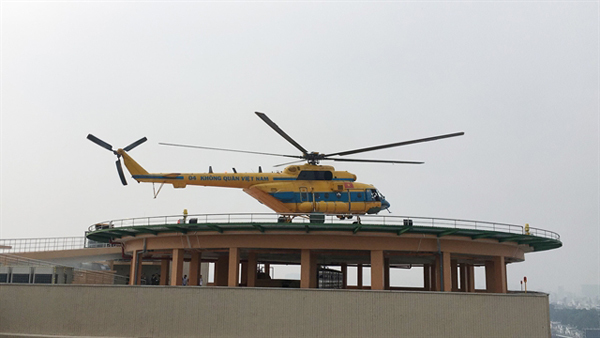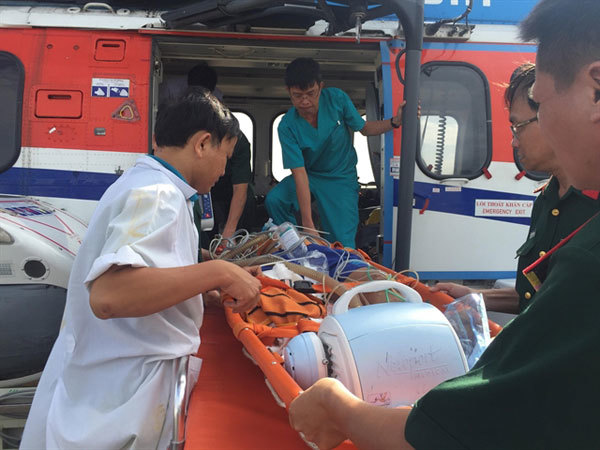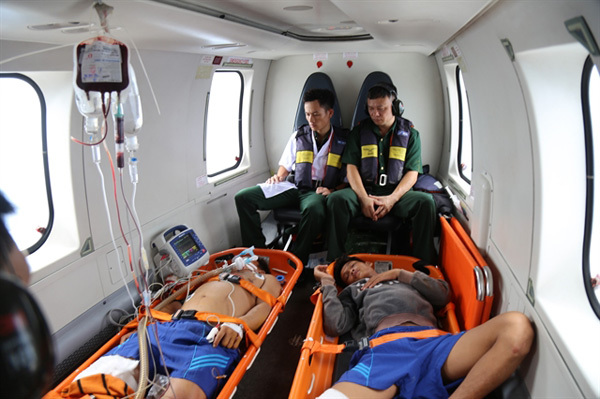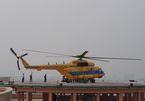 |
| Military Hospital 175’s heliport in HCM City. VNA/VNS. Photos Dinh Hang |
A medical air ambulance team is sent by helicopter immediately when the Military Hospital 175’s leaders conclude that an aero medical evacuation (AME) is necessary to save patients’ lives.
The operations normally require approval and prompt coordination of the National Search and Rescue Department under the Ministry of Defence, General Staff Department, Air Defence and Air Force, the Military Hospital 175 medical team, and helicopter transport divisions.
Since 2016, the Military Hospital 175 medical team has provided emergency treatment and evacuation for hundreds of fishermen, civilians and soldiers in the southern islands and remote areas of Vietnam.
 |
| Military Hospital 175’s team provides medical air ambulance services. |
The Military Hospital 175 AME team comprises the best and most experienced emergency doctors and nurses of its parent hospital.
Regular AME training is also conducted by instructors from Australia. Senior Lieutenant Doctor Dinh Van Hong, one of the team members, said: “Flying at night time and having a cold-pack dinner on board is business as usual. The patient’s golden time window is critical! We are also familiar with helicopter drop-off at the island whenever extreme weather prevents the helicopter from landing.”
Hong said the team's first successful AME case involved a soldier on duty at the Barque Canada Reef (Dao Thuyen Chai) on the Spratly Islands of Khanh Hoa Province.
The patient, 25, had an accident on duty, leading to a risk of a blunt thoracic trauma, which could have caused hemothorax (the presence of blood in the pleural space) and pneumothorax (the presence of air or gas in the pleural cavity).
“Acute respiratory failure could have occurred and killed him, so his only chance was an AME to bring to the Military Hospital 175," said Dr Hong.
“Air transport is not risk free, however. Helicopter standard altitudes of 2,000 metres will definitely cause an increase in air pressure in the patient’s rib-cage. This will worsen the pneumothorax and may even result in death in transport.”
“Our medical team discusses this with the air crew, so they fly at the lowest possible altitude. A smooth ride at 1,000 metres above sea level is safer for the patient.”
“The patient can deteriorate very quickly in the air with signs of respiratory failure. We had to immediately insert a drainage tube and use endotracheal intubation.”
“All clinical procedures are more challenging when we fly due to air pressure changes, turbulence and altitude fluctuations. Low oxygen levels also cause anxiety for both the medical team and the patient,” Dr Hong added. “Luckily, after a few days at Military Hospital 175, our patient recovered and was discharged."
 |
| Two fishermen on Thuyen Chai Island of the Truong Sa (Spratly) archipelago in Khanh Hoa Province. They were transported to the Military Hospital 175 for treatment after an accident. |
Two other fishermen on the Spratly archipelago suffered from decompression sickness, also known as "the bends".
This can occur when people dive too deeply and swim back toward the surface quickly. The water pressure around them decreases and the nitrogen dissolves into their blood and forms bubbles in their tissues or blood. These nitrogen bubbles cause decompression sickness.
“The nitrogen bubbles can damage their brain,” Hong explained.
The two fishermen received emergency treatment which maintained their blood pressure and they were administered high-flow oxygen. Fluids also were given at Truong Sa Health Facility.
However, the optimal treatment was the use of a hyperbaric oxygen chamber, a high-pressure chamber in which the patient receives 100 per cent of oxygen to reverse the pressure changes that allowed gas bubbles to form in the blood stream. It drives nitrogen back into its liquid form so that it can be cleared gradually from the body over a period of hours.
The Truong Sa Health Facility did not have a hyperbaric oxygen chamber so the patients had to be transported to the Military Hospital 175, which has the equipment.
The Military Hospital 175 decided to evacuate both patients on a helicopter. High-flow oxygen was administered on board. Both patients were then admitted to the hospital for treatment by the hyperbaric oxygen chamber.
Major General Nguyen Hong Son, director Military Hospital 175, said: “The AME team enhances the quality of our health service, enables us to reach out to remote areas, and connects us with international partners for an international standard of air ambulance practices. This will be one of the focuses of our professional development plan in the foreseeable future with the target of establishing a Center of Rescue, Emergency and Disaster Medicine at the regional and global levels.”
The Military Hospital 175 can deploy its on-call air ambulance team within less than one hour on a 24/7 basis.
"But the new helipad on top of the Orthopedics and Trauma Center of the Hospital will definitely be the game changer," Son said.
“Previously, the AME helicopter would land at Tan Son Nhat International Airport. Sometimes, the traffic jam from the airport to the Hospital tragically took away our time advantage to save the patients," said Son. “I hope after other helipads are built at People’s Hospital 115, the Oncology Hospital and the City Children’s Hospital, HCM City's AME capability will be expanded.” VNS
Gia Loc

Air medical service debuted in HCM City
The Hospital for Traumatology and Orthopaedics under the Military Hospital 175 in HCM City held a pilot medical helicopter trial on November 8.